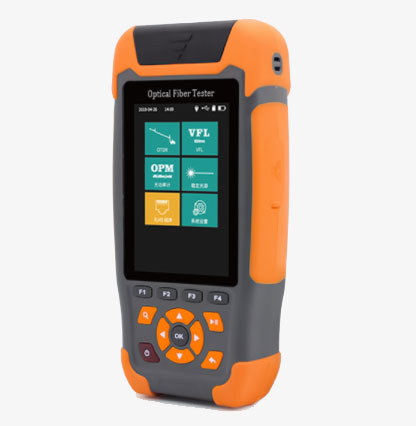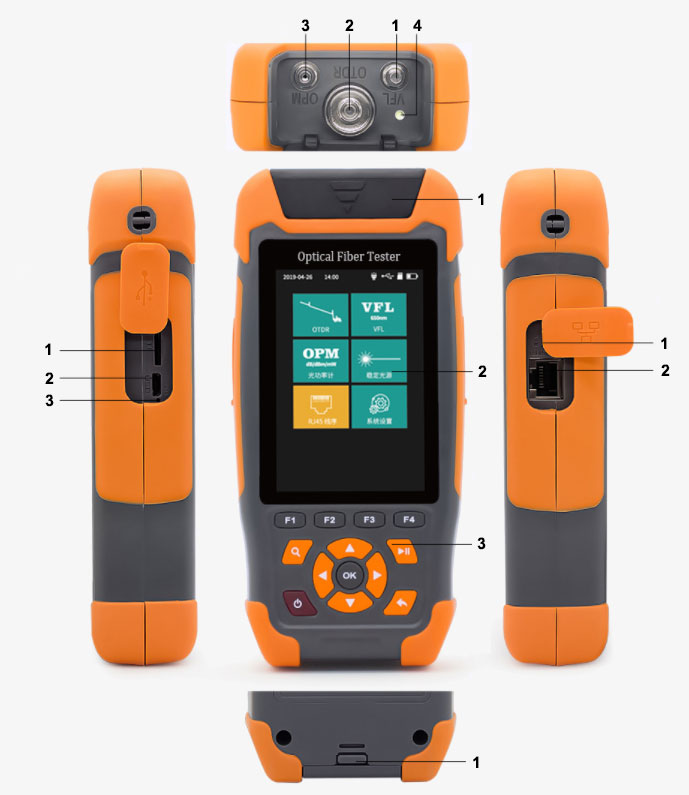Buy OTDR testing equipment online, sisco multimode OTDR fiber tester with 3.5-inch LCD display, measurement range up to 64km, wavelength 1310/1550nm, dynamic range 22/20dB, users can more intuitive understanding and analysis of the entire fiber link status and failure.

6 functional modules to meet your testing needs
- High-performance test, 20dB dynamic range, optical time domain reflectometer, 20h ultra-long standby.
- Multi-functional standard, optical time domain reflectometer/optical power meter/visual fault location/stable light source/RJ45 line sequence measurement/flashlight.
- Simple operation, one key automatic test, automatic file saving, automatic analysis of test results.
- Fast batch processing of SOR files, remote upgrade, USB data file batch export.
Application
OTDR (optical time domain reflectometer) uses the backward scattered light generated when the light propagates in the fiber to obtain attenuation information, which can be used to measure fiber attenuation, splice loss, fiber fault location and understand the loss distribution along the length of the fiber, etc. OTDR tester is an essential tool in fiber optic cable construction, maintenance, and monitoring.

| Model | SISCO-TP2800D |
| Function | OTDR/OPM/LS/VFL /RJ45 line sequence/Flashlight |
| Wavelength | 1625nm |
| Dynamic Range | 22/20dB |
| Event Blind Zone | 3m |
| Fading Blind Area | 8m |
| Measurement Range | 500m~65km |
| Sampling Points | 16k~256k |
| Sampling Resolution | 0.05m~8m |
| Data Storage | Internal: ≥ 600, external: expandable TF card |
| Laser Safety Level | Class 2 level |
| File Format | SOR standard file format |
| Interface Type | FC/UPC (interchangeable SC, ST) |
| Optical Power Meter | |
| Wavelength Range | 800nm~1700nm |
| Connector | Universal connector FC/SC/ST |
| Measurement Range | - 50dBm ~ + 26dBm |
| Uncertainty | 5% |
| Frequency Identification | CW/270/330/1k/2kHz |
| Calibration Wavelength | 850/980/1300/1310/1490/1550/1625/1650nm |
| Light Source | |
| Laser Type | FP-LD |
| Output Wavelength | 1310nm/1550nm± 20nm |
| Output Power | ≥- 5dBm |
| Modulation Frequency | 270/330/1k/2kHz |
| Stability | CW, +0.5dB/15min (tested after 15min power on warm-up) |
| Interface Type | FC/UPC (interchangeable with SC, ST) |
| VFL Integrated Red Light | |
| Working Wavelength | 650nm±20nm |
| Output Power | ≥10mW |
| Working Mode | CW/1Hz/2Hz |
| Whole Machine Index | |
| Display | 3.5-inch color LCD screen |
| Data Interface | Micro USB |
| Expandable Storage | TF card (optional) |
| Power Supply | Lithium polymer battery: 3.7V, 4000mAh power adapter: 5VDC, 2A |
| Battery Life | Standby>7.5 hours, measurement>4 hours. |
| Operating Temperature | -10°C~ +50°C |
| Storage Temperature | -20°C~ +70C |
| Relative Humidity | 0~95% non-condensing |
| Overall Weight | Main unit weight 0.360kg; including packaging 0.760kg |
| Dimension | 173mmx 82mmx37mm |
Details

Top
- VFL (visual fault locator) interface
- OTDR/LS optical interface
- OPM (Optical Power Meter) interface
Side left
- TF (Micro SD) card slot
- Micro USB (charge/connect to a computer to copy data)
- LED charging indicator
Main view
- Dustproof cover
- 3. 5-inch color LCD display
- Function buttons
Side right
- Reset interface
- RJ45 test interface
Back bottom
- RJ45 test distal
Packing List
- 1 x Power Adapter
- 1 x Data Cable
- 1 x SC to Interface
- 1 x CD-ROM (with analysis software)
- 1 x Operation Manual
- 1 x Certificate of Conformity / Warranty Card
- 1 x Test Report
- 10 x Cleaning Swabs
- 1 x Instrument-Specific Bag
Q1: What is an OTDR used for?
A1: OTDR is a fiber optic instrument used to characterize, troubleshoot and maintain optical communication networks. OTDR testing is performed by transmitting and analyzing pulsed laser light through an optical fiber.
Q2: What is fiber loss?
A2: Optical fiber loss is the attenuation per unit length of optical fiber in dB/km, the level of fiber loss directly affects the transmission distance or the distance between relay stations, therefore, understanding and reducing the loss of optical fiber is of great practical significance for fiber optic communication.
Q3: What is an optical time domain reflectometer?
A3: The optical time domain reflectometer is a fiber optic tester used to test the characteristics of optical communication networks. OTDR is designed to detect, locate and measure events at any location on a fiber optic link. OTDR requires access to only one end of the link and works in a manner similar to a one-dimensional radar system. By providing graphical trace characteristics of the fiber under test, the user can obtain a graphical representation of the entire fiber link.
Tips: How to judge the fiber quality of OTDR?
Under normal circumstances, the slope of the OTDR test light curve body (single tray or several trays of fiber optic cable) is basically the same, if the slope of a section is larger, it indicates that this section is more attenuation. If the main body of the curve is irregularly shaped, and the slope is more undulating, curved, or arc-shaped, it indicates that the fiber quality is seriously deteriorated and does not meet the communication requirements.
Thank you for buying industrial test and measurement equipment on SISCO.com, all products sold by SISCO and the partner cover a 12 months warranty, effective from the date of receiving the products.
What is covered?
SISCO is responsible for providing free spare parts, and free technical support to assist the customer to repair the defective products until the problem is solved.
What is not covered?
- Product purchased from anyone other than a SISCO store or a SISCO authorized reseller.
- Expendable parts.
- Routine cleaning or normal cosmetic and mechanical wear.
- Damage from misuse, abuse or neglect.
- Damage from use of parts other than SISCO approved.
- Damage from use outside the product’s usage or storage parameters.
- Damage from use of parts not sold by SISCO.
- Damage from modification or incorporation into other products.
- Damage from repair or replacement of warranted parts by a service provider other than a SISCO authorized service provider.
- Damage caused by the application environment not meeting the product usage requirements and the failure to perform preventive maintenance.

